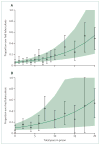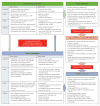The perfect storm: incarceration and the high-risk environment perpetuating transmission of HIV, hepatitis C virus, and tuberculosis in Eastern Europe and Central Asia
- PMID: 27427455
- PMCID: PMC5087988
- DOI: 10.1016/S0140-6736(16)30856-X
The perfect storm: incarceration and the high-risk environment perpetuating transmission of HIV, hepatitis C virus, and tuberculosis in Eastern Europe and Central Asia
Abstract
Despite global reductions in HIV incidence and mortality, the 15 UNAIDS-designated countries of Eastern Europe and Central Asia (EECA) that gained independence from the Soviet Union in 1991 constitute the only region where both continue to rise. HIV transmission in EECA is fuelled primarily by injection of opioids, with harsh criminalisation of drug use that has resulted in extraordinarily high levels of incarceration. Consequently, people who inject drugs, including those with HIV, hepatitis C virus, and tuberculosis, are concentrated within prisons. Evidence-based primary and secondary prevention of HIV using opioid agonist therapies such as methadone and buprenorphine is available in prisons in only a handful of EECA countries (methadone or buprenorphine in five countries and needle and syringe programmes in three countries), with none of them meeting recommended coverage levels. Similarly, antiretroviral therapy coverage, especially among people who inject drugs, is markedly under-scaled. Russia completely bans opioid agonist therapies and does not support needle and syringe programmes-with neither available in prisons-despite the country's high incarceration rate and having the largest burden of people with HIV who inject drugs in the region. Mathematical modelling for Ukraine suggests that high levels of incarceration in EECA countries facilitate HIV transmission among people who inject drugs, with 28-55% of all new HIV infections over the next 15 years predicted to be attributable to heightened HIV transmission risk among currently or previously incarcerated people who inject drugs. Scaling up of opioid agonist therapies within prisons and maintaining treatment after release would yield the greatest HIV transmission reduction in people who inject drugs. Additional analyses also suggest that at least 6% of all incident tuberculosis cases, and 75% of incident tuberculosis cases in people who inject drugs are due to incarceration. Interventions that reduce incarceration itself and effectively intervene with prisoners to screen, diagnose, and treat addiction and HIV, hepatitis C virus, and tuberculosis are urgently needed to stem the multiple overlapping epidemics concentrated in prisons.
Copyright © 2016 Elsevier Ltd. All rights reserved.
Conflict of interest statement
Declaration of interests We declare no competing interests.
Figures






References
-
- Singer M. introduction to syndemics: a systems approach to public and community health. San Francisco, CA: Jossey-Bass; 2009.
-
- Joint United Nations Programme on HIV/AIDS (UNAIDS) [accessed May 28, 2016];Global AIDS Update 2016. http://www.unaids.org/sites/default/files/media_asset/global-AIDS-update....
-
- WHO. Global update on HIV treatment 2013: results, impact and opportunities. Geneva: World Health Organization; 2013.
-
- Degenhardt L, Mathers BM, Wirtz AL, et al. What has been achieved in HIV prevention, treatment and care for people who inject drugs, 2010–2012? A review of the six highest burden countries. Int J Drug Policy. 2014;25:53–60. - PubMed
Publication types
MeSH terms
Substances
Grants and funding
LinkOut - more resources
Full Text Sources
Other Literature Sources
Medical

